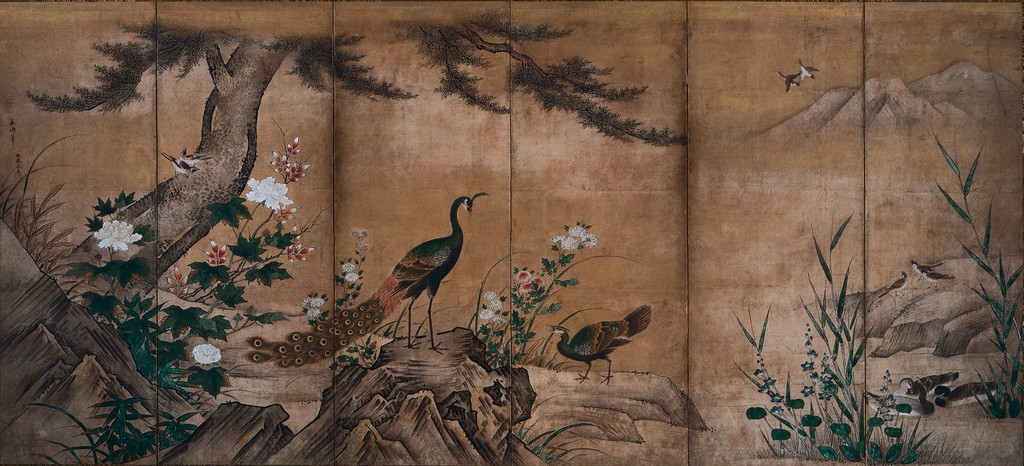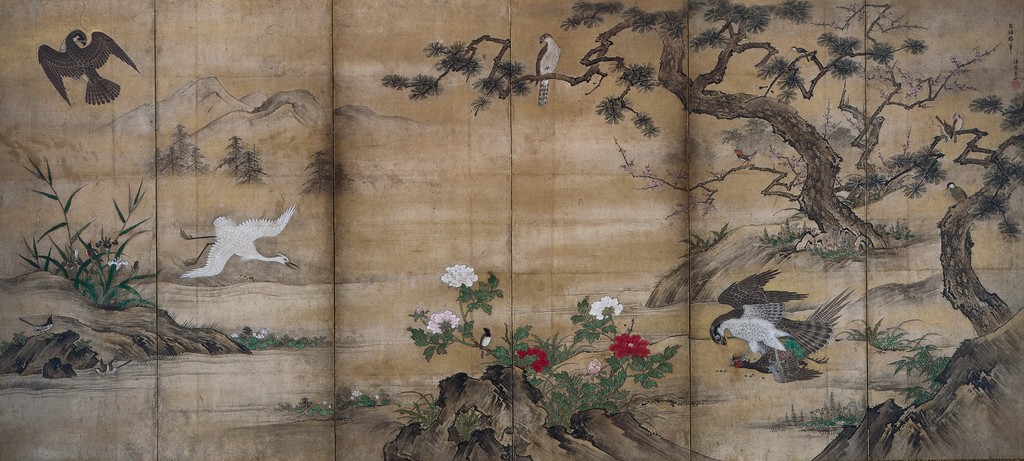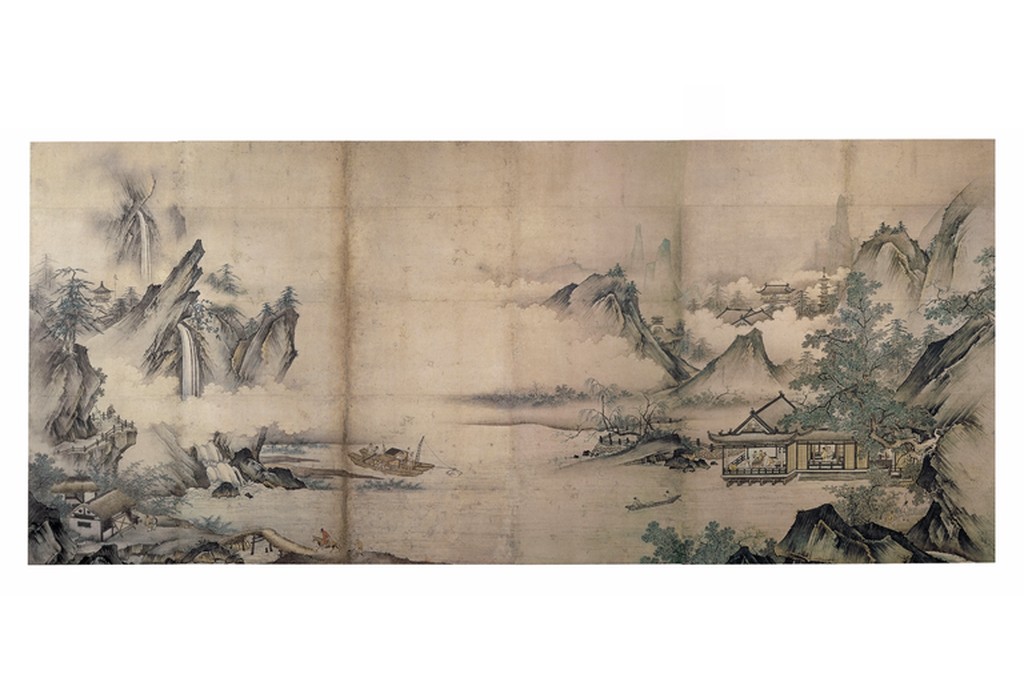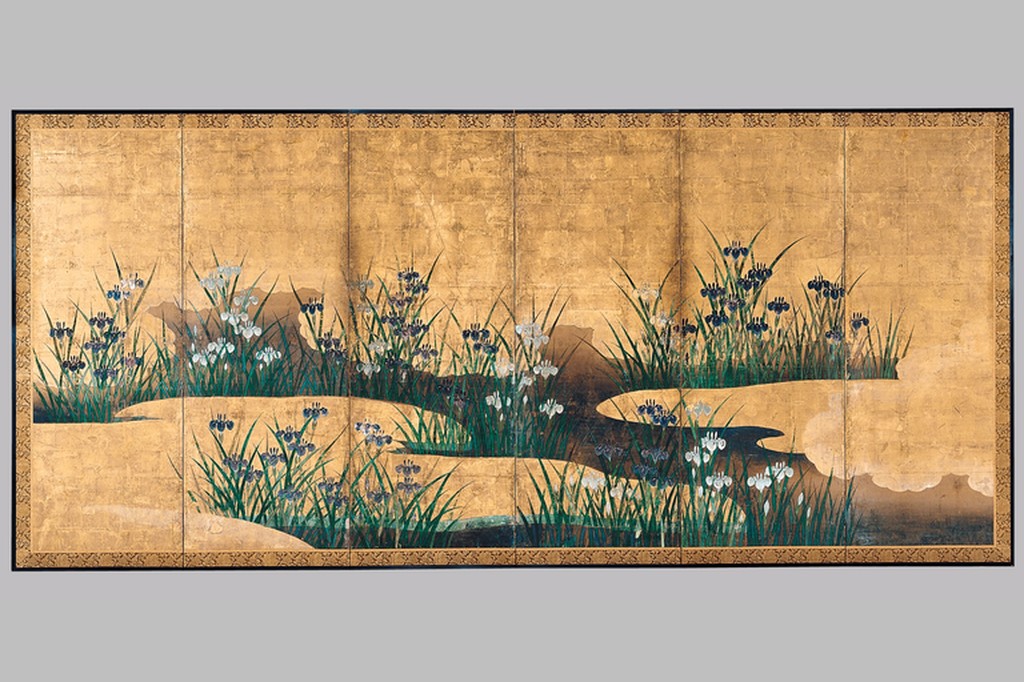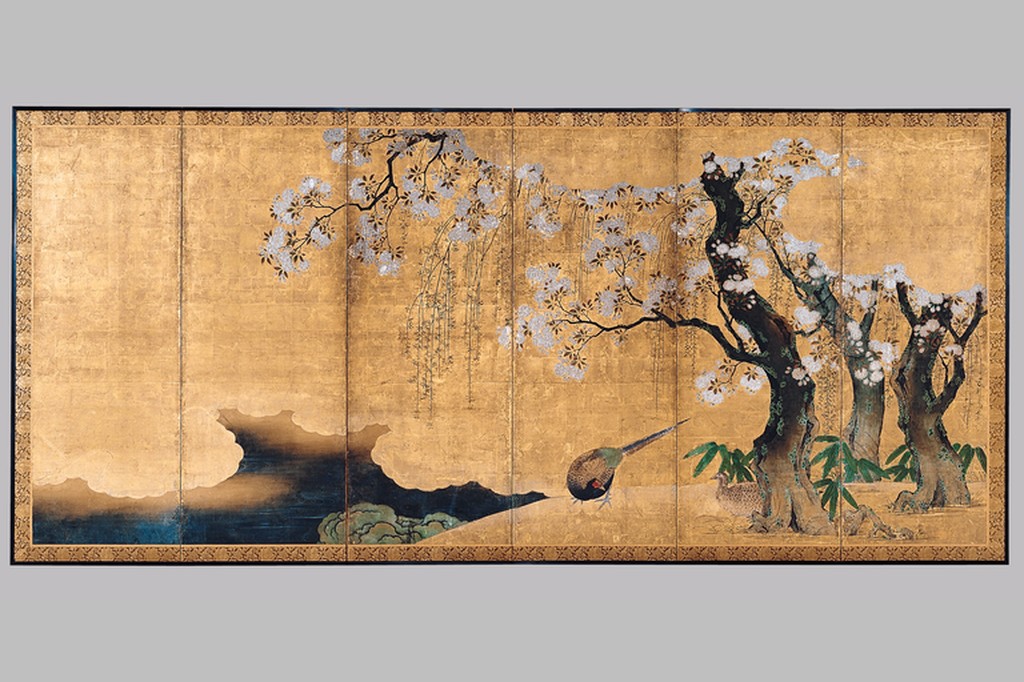
The Kano School of Painting was one of the most famous schools of Japanese painting in history. It produced a string of major Japanese artists and dominated Japanese art from the 15th to 19th century. The school was originally founded by a painter from Kyoto named Kano Masanobu (1430-1530), who specialized in Zen paintings. He went on to train his son Kano Motonobu (1476-1559), and it was Motonobu who is credited with the cultivation of the Kano style of painting. This style was something nobody in Japan had seen before and was created by merging aspects of traditional Chinese painting with typical Japanese painting. The Chinese painting that Kano Masanobu had mastered featured a strong emphasis on brushwork. It also featured a predominance of ink and little to no color was used. Most of these paintings featured Chinese subjects, especially Zen patriarchs or Chinese landscapes. Kano Masanobu took some of these aspects and combined them with properties of classic Japanese paintings. Some of these qualities were decorativeness, patterns, and bright colors. It was the amalgamation of these two artistic styles that birthed the now-famous Kano style of painting. The Kano paintings had some features of their own as well. It was common for these paintings to feature a high contrast between dark and light. They often depicted landscape scenes, animals, figures, or nature. The paintings were frequently set against a gold foil or painted on gold leaf paper. Finally, it was common for these paintings to be turned into fusuma or byobu. Fusuma is the word for sliding doors and byobu is the word for folding screens. These sliding doors and folding screens were used to decorate castles and temples. Many Kano-style paintings were found in these settings because the Kano School had a strong relationship with Ashikaga and Tokugawa shoguns and Zen monks, and the military rulers enjoyed having their walls decorated with the Kano paintings. In fact, Kano School painters worked mainly for the nobility and were paid very generously for their works.
Work Type: Painting
Date: 16th century
Material: pair of six-fold screens, ink, color and gold on paper
Measurements: Overall: 172.5cm x 356cm, Closed: 172.5cm x 61cm x 11.3cm
Repository: The Cleveland Museum of Art
Creator: Kano Shoei
Description: This painting by Kano Shoei was created in the 16th century and was made into a folding screen (byobu). It features a nature scene with birds, trees, and flowers with rocks in the foreground and mountains in the background. Distinct visual components of this painting are the use of gold on paper, and the vibrant colors used throughout the nature scene. The bright red of the flowers and the rich green of the plants and leaves are eye-catching for the viewer. There is incredibly detailed brushwork on the branches of the trees, especially on the left-hand side of the left panel and the right-hand side of the right panel. The strong strokes of ink that make up the rocks below the peacock also give the piece a lot of three-dimensionality.
Work Type: Painting on pair of six-panel folding screens
Date: mid-to-late 16th century
Location: Japan
Material: Ink and light color on paper
Measurements: Each 61 x 142 1/8 in. (154.9 x 361 cm)
Repository: Asia Society Museum, New York, USA
Creator: Unknown
Description: This painting on six-panel folding screens was created by an unknown artist during the mid to late 16th century. This landscape painting depicts villages and mountains separated by bodies of water. A clear and distinct visual component in this painting is the contrast between light and dark. The lightness of the clouds and water is juxtaposed with the dark brushstrokes that make up the mountains and villages. Not as much color is used here as is typical for Kano paintings, but there are some yellow tones in the buildings and structures in the villages and some green shades in the trees that litter the mountains and cliffs.
Title: Pheasants Under Cherry and Willow Trees and Irises and Mist
Work Type: Painting on pair of six-panel folding screens
Date: Edo period, first half 17th century
Location: Japan, Kyoto Prefecture,
Material: Ink and color on gold leaf on paper
Measurements: Each 63 x 143 1/4 in. (160 x 363.9 cm)
Repository: Asia Society Museum, New York, USA
Creator: Kano Ryokei
Description: This is a painting on two six-panel folding screens created by Kano Ryokei in the first half of the 17th century. As stated in the title, this painting displays birds under trees in a nature scene. The gold leaf paper background is very striking, as it is in very good condition. A key feature of these six-panel folding screens is the border that surrounds them both. The intricate pattern wraps around the entirety of the painting and shows a decorativeness that is common in Japanese paintings. Finally, this painting uses vibrant colors throughout the scene, especially bright green in the plants and the silver of the flowers.
Bibliography:
Motonobu Kano, Asian; Far East Asian; Japanese, 1476 – 1559, (artist),. Birds, Trees and Flowers. 1476-1559. Artstor, library.artstor.org/asset/AMICO_CL_103799915
Kano Mitsunobu (Japanese, 1565-1608), Kano Shoei (Japanese, 1519-1592). <!– <button class=”sort”>001</button> –>Birds, Trees, and Flowers, See all records within the <A HREF=https://library.artstor.org/#/search/Part%20of%20a%20Set%20″1948.128″;size=72;page=1;colId=100069507;sort=1>set</A>. late 1500s. Artstor, library.artstor.org/asset/24593859
Attributed to Kano Ryokei, Asian; Far East Asian; Japanese, Died 1645. Pheasants under Cherry and Willow Trees and Irises and Mist. Edo period, first half 17th century. Artstor, library.artstor.org/asset/AMICO_ASIAN_SOCIETY_103813404
Attributed to Kano Ryokei, Asian; Far East Asian; Japanese, Died 1645. Pheasants under Cherry and Willow Trees and Irises and Mist. Edo period, first half 17th century. Artstor, library.artstor.org/asset/AMICO_ASIAN_SOCIETY_103813403
Attributed to Odawara Kano School, Asian; Far East Asian; Japanese. The Four Seasons. Muromachi period, mid- to late 16th century. Artstor, library.artstor.org/asset/AMICO_ASIAN_SOCIETY_103813393
Attributed to Odawara Kano School, Asian; Far East Asian; Japanese. The Four Seasons. Muromachi period, mid- to late 16th century. Artstor, library.artstor.org/asset/AMICO_ASIAN_SOCIETY_103813394
Mei Qing, Asian; Far East Asian; Chinese, 1623 – 1697, (artist),. Landscapes after Various Styles of Old Masters. 1690. Artstor, library.artstor.org/asset/AMICO_CL_103800777
In the Style of, Kanô Eitoku, Japanese, 1534-1590. Women at Chinese Court. 16th century. Artstor, library.artstor.org/asset/MMA_IAP_1039652447
Department of Asian Art. “The Kano School of Painting.” Metmuseum.org, Metropolitan Museum of Art, Oct. 2003, https://www.metmuseum.org/toah/hd/kano/hd_kano.htm.
Phillips, Quitman E. “Honchō Gashi and the Kano Myth.”
Archives of Asian Art 47 (1994): 46–57. http://www.jstor.org/stable/20111243.
Doyouknowjapan.com. “Japanese Painting.” Encyclopedia of Japan, https://doyouknowjapan.com/painting/.
